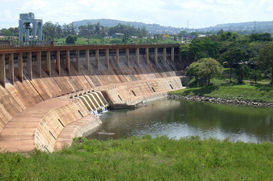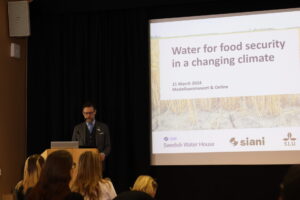SIWI paper analyses benefits, risks and best practice in water storage
"Large-scale water storage in the water, energy and food nexus: Perspectives on benefits, risks and best practice", by Mr. Andreas Lindström and Dr. Jakob Granit, provides an overview of the current status of large scale artificial water storage development and its functions in the water, energy and food security nexus.
The paper presents a typology of water storage structures and provides an analysis of the risks, benefits and trade-offs posed by different storage options. It also highlights good practices and lessons learned from past experiences and explores emerging opportunities for water storage schemes to enhance water, energy and food security in the future.
- Download the full paper here.
Key findings
1. Large-scale water storage supports economic development, builds water security and buffers against increasing rainfall variability.
Several examples from around the world demonstrate how water storage has supported rapid socio-economic development in many regions and countries. Increases in irrigated agriculture land areas have fostered greater food security and electricity generated from hydropower have contributed to large-scale grid-based electrification to boost industrial outputs and contributed to economic growth and human development. Hydropower plays an expanding role in integrated power systems and can enable increased use of intermittent renewable energy sources such as wind and solar power. Hydraulic infrastructure and water storage also play an important part in protecting people from the impacts of unpredictable hydrological variability, floods and droughts.
2. Well-designed water storage and hydropower systems can enhance both climate change adaptation and mitigation, but such systems must also plan for a more extreme and variable climate.
Integrated regional system planning for water and energy use can support a transition to decarbonise the energy supply chain and provide solutions to meet growing energy demand. While water storage sites do produce some greenhouse gases, their emissions are much lower than conventional fossil fuel. More research is needed on greenhouse gas emissions from reservoirs and possible solutions to reduce them. Hydropower can be developed to mitigate climate change through wider use of renewable energy sources. Existing and future dam and storage assets need to consider the impacts of climate change induced extreme weather conditions and changes in run-off variability. Efficient modelling and planning, including reliable forecasting of different scenarios, will play a vital part in present and future project development. In many places, well designed large scale water storage development is a strategic management response to establish water security and adapt to long-term climate change. This requires, however, thorough options and impact analysis to determine if a storage project is a viable choice.
3. Environmental and social consequences at the local and regional levels need to be addressed up-front when developing water storage.
Issues of resettlement, compensation and environmental degradation are critical factors to consider in all water storage projects. In many cases, projects will affect people and ecosystems, often significantly. Consequences can include livelihood losses, impacts on traditional and cultural values, and degradation of public health. Compensation for individuals and communities has been inadequate in some cases. Successful strategies to engage local populations can provide guidance when planning new projects and help create new and meaningful livelihood opportunities for people that are affected by storage construction.
4. There are several ways to mitigate negative impacts from water storage in the project design, implementation and initial planning stages.
Environmental and social impacts should be addressed through proven governance and technical solutions at the early planning and design stages. Strategic Environmental Assessments (SEA) are, for example, gaining increasing attention globally as an instrument to identify environmental and social issues in major development programmes and incorporate strategies to address them into the planning, project development and investment finance process. This includes engaging representatives of populations that will be affected by storage construction early in the planning process, and maintaining their involvement throughout the detailed project design (pre- and full feasibility) and implementation stages. Methods and techniques to ensure good project planning and stakeholder engagement tools have been developed actively since the World Commission on Dams produced its industry benchmark report in 2000.
5. Expected benefits from initial stages of storage projects plannings may at times promise too much, but there are also cases where outcomes exceed expectations.
Many water storage structures do not reach their expected potential predicted at pre-commissioning stages. Social and environmental trade-offs may overtake the economic benefits. Hydropower dams, however, exceed the target set for economic returns and development outcomes more than any type of other water storage. Existing hydropower electricity generation capacity can also be improved through technical upgrades during the project’s life-cycle. Reasons for lower than expected outputs for other storage types are often consequences of gaps between the initial planning assessments and actual carrying out capabilities in subsequent project stages of water storage projects. This can ultimately lead to chronic operational problems. Increasing the efficiency of existing storage schemes provides a major opportunity for increasing output through improvements in water storage technology.








